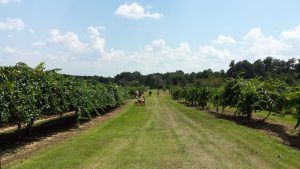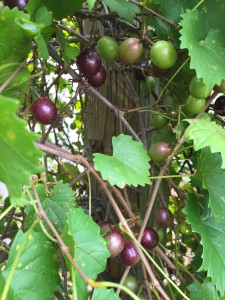
There is something deeply satisfying about plucking fruit off a plant growing outside and tasting it right off the vine/bush/tree. Since childhood, I have reached carefully through the tiny and numerous thorns of blackberry bushes growing in the woods, hoping the berry I’d worked for was more sweet than tart. One vine-ripe fruit that never disappoints, however, is the native muscadine grape (Vitis rotundifolia) . Granted, before eating for the first time you should be aware that the thick skin will give way to a gelatinous goo with several seeds, but their refreshing taste on a hot summer day is unlike any other. Beloved by deer and other mammals and birds of all types, it’s hard to find a lot of muscadine grapes available in the woods because the wildlife has likely beaten you to them. Their jagged, heart-shaped leaves are easily recognizable, though, so at least you know where to look once the grapes start to form. I would be remiss if I didn’t mention these grapes also go by the term “scuppernong”, which is a colloquial term for the lighter green/bronze (and more common) muscadines in the southeast.

While tasty on their own, muscadines are most prized for making jelly and wine. We used to have an older Southern Baptist deacon and neighbor who would slip us both, with a wink and an implied promise not to tell the preacher about the wine. Winemaking in Florida is an old tradition, and several local wineries specialize in these sweeter wines, like Chatauqua Vineyards and Winery in DeFuniak Springs. They are often blended with other fruits like blueberry and strawberry. Our Extension colleagues with the Florida Agricultural and Mechanical University (FAMU) have a widely recognized viticulture program, and I recommend their resources if you are interested in growing muscadines yourself.

As for wild muscadines, you can find the vines all over the place, from shady forests to sunny beach dunes. The vines can be up to 100 feet long, climbing with the help of small tendrils. Inconspicuous greenish white flowers form in late spring, with fruit ripening in late summer/early fall. It serves you well to learn field identification for the muscadine, as it is a sweet treat on a hot Florida day.
 1
1
